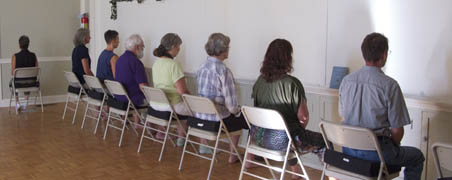It is helpful to receive meditation instruction directly from someone who has experience in the particular form of meditation you wish to learn. Please contact us if you would like instruction in Serene Reflection Meditation (Zen). This can be arranged to be given at an in person meeting or through individual appointments. Instruction can cover a basic introduction to the practice or provide an opportunity for questions about Zen. You may also contact Reverend Vivian, our resident monk, with further questions or for spiritual counseling.

Recommended Sources
Sitting Buddha by Reverend Master Daishin Morgan. It is available for download at the Throssel Hole Buddhist Abbey website or from book stores.
Finding the Still Point by John Daido Loori. Further readings, illustrations of sitting postures and a list of Dharma talks are available on the Shasta Abbey’s website. Throssel Hole Buddhist Abbey also offers recommended reading as well as a video on meditation given by Reverend Master Daishin Morgan.
Meditation Instructions
Meditate in a quiet, well-ventilated room, where you feel comfortable and at ease. The room should be neither too bright not too dark. Wear comfortable clothing that does not restrict the waist or the legs. Find the most stable position for you, sitting on a chair or meditation bench or cushion. If you are extremely flexible you can use a meditation cushion, sitting in the cross-legged position, either full or half-lotus. Sit on the forward third of the cushion and with each meditation period alternate the leg you place on top. Do not persist in using a meditation cushion if you find the position painful.

To center yourself, sway the body gently from left to right then backwards and forwards. Allow the spine to rise naturally out of a strong and stable pelvic floor, with the two natural curves of the spine forming at the neck and small of the back. Be aware of the head resting in line with the shoulders, weightlessly rising up to the ceiling; the chin is slightly tucked in and relaxed. The tongue is held lightly against the back of the top teeth with the lips and teeth closed. Breathe naturally.
Rest the right hand in the lap with the left hand in the palm of the right hand (some left-handed people find it useful to do the reverse). The tips of the thumbs touch lightly, forming an oval or circle. Keep the eyes open and lowered (do not drop the head), allowing the gaze to fall gently on the wall or on the floor in front of you. Keep the eyes in focus but do not stare. If you wear glasses, leave them on or take them off, as you wish.
Slowly take two or three breaths through the nose, to begin the circulating breathing pattern. Follow the breath up the back on inhalation and down the front of the body on exhalation, thus describing a circle. Then breathe as you would normally. Sit steadily with an alert and bright mind, neither suppressing nor indulging thoughts that may arise. Allow thoughts and sensations to arise and pass naturally, be at ease with them, but do not engage in deliberate thought (getting involved with the thoughts that come up.) When the mind wanders, just notice and bring yourself back to being still and mindful. You can use the circular breathing pattern described above to help you achieve this. “Sitting still with no deliberate thought is the important aspect of Serene Reflection Meditation.”
Meditate regularly every day if possible, even if only for a few minutes. Morning and evening, or a quiet time in your schedule, are best. Do not meditate in the formal positions directly after meals, when physically exhausted or in extremes of temperature. It is good to meditate for a specific length of time and stick to it, be it five, ten or thirty minutes. It is best not to exceed 45 minutes at one sitting period without walking meditation or relaxing the body for at least ten minutes. Meditation with a group is very helpful, giving support and inspiration.